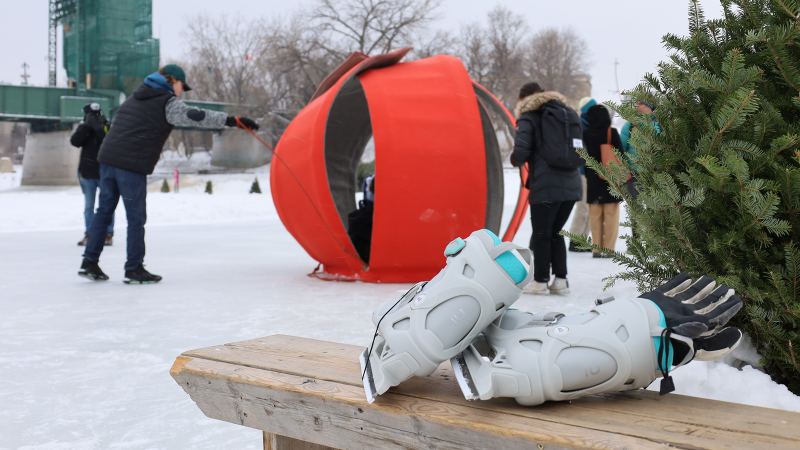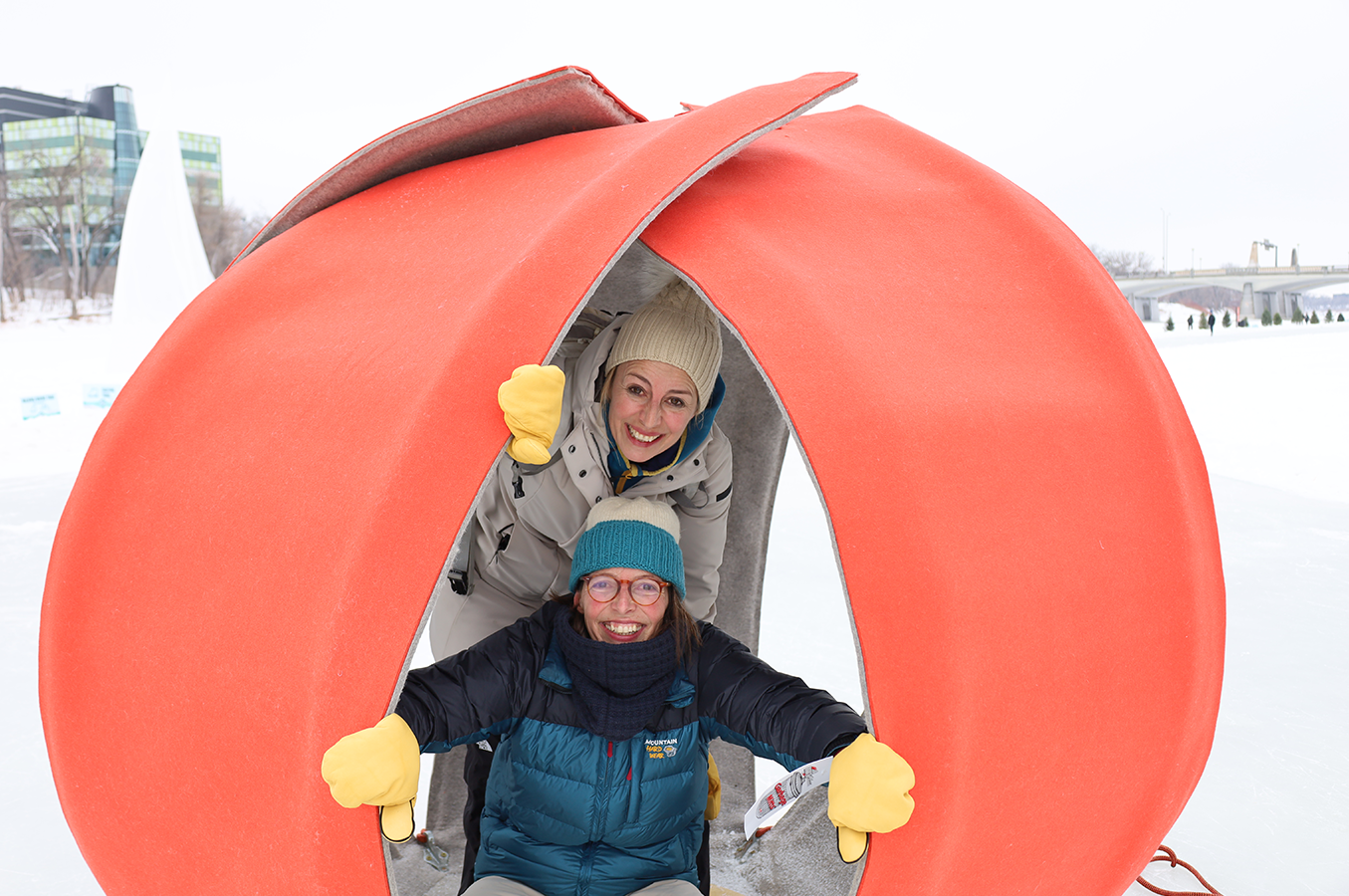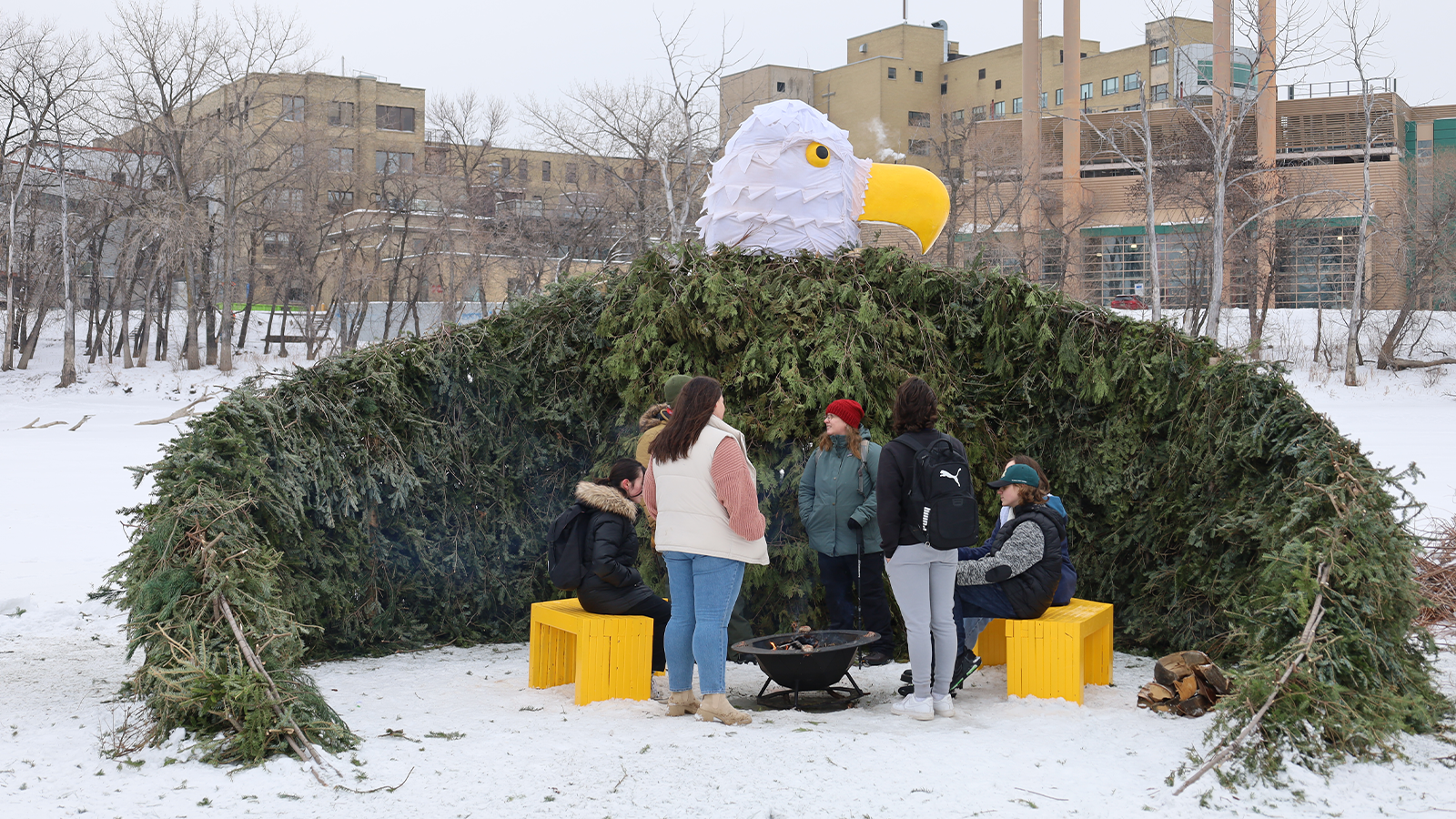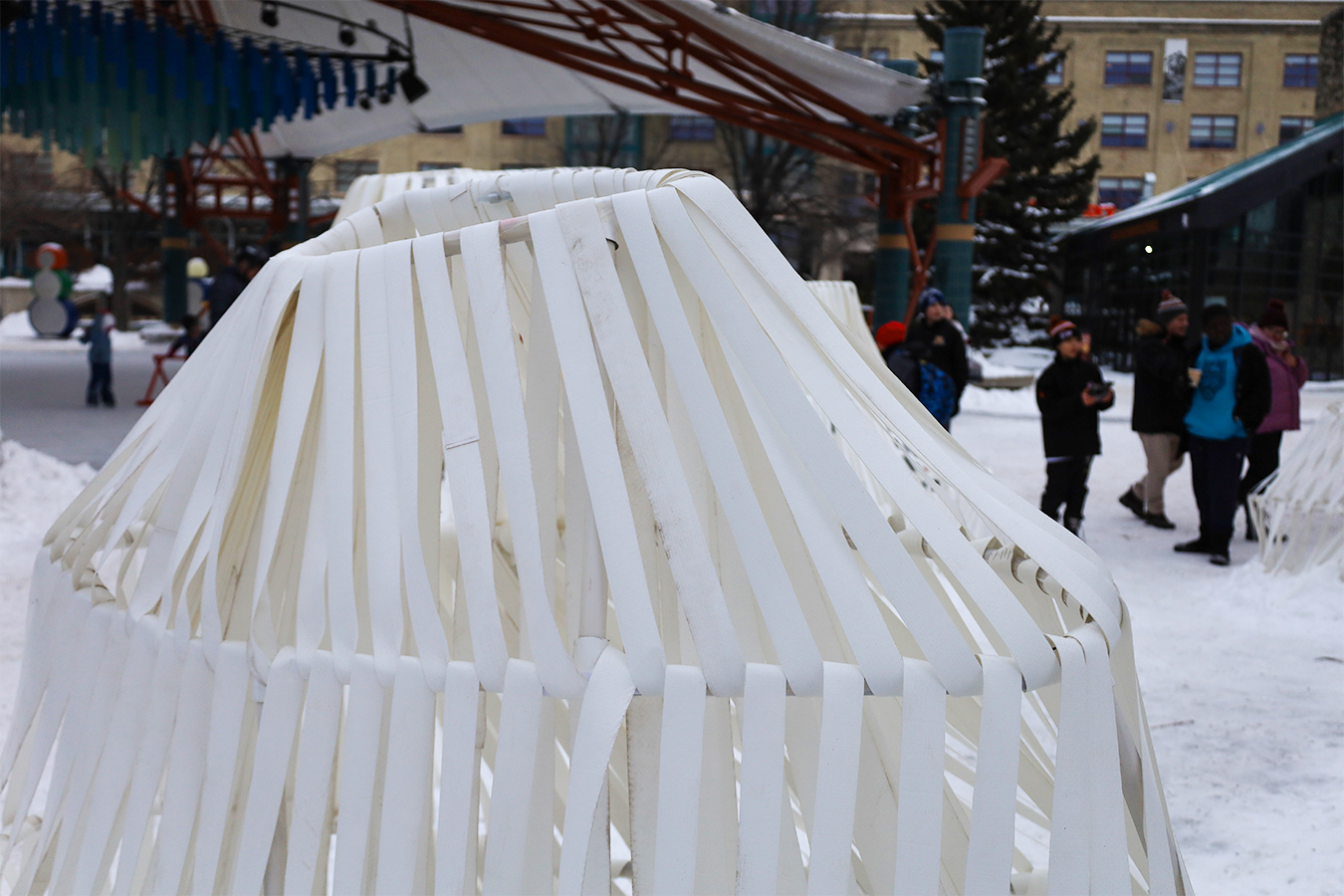
From an eagle to a beaver, from a fish out of water to an ice curtain, from a Stonehenge replica to an ode to dim sum, this year’s six new Warming Huts are set to bring fun, intrigue, and allure to the winter experience at The Forks. The Warming Huts v.2024 winning teams are on-site bringing their art and architecture installations to life on the Nestaweya River Trail presented by The Winnipeg Foundation and around Winnipeg 150 Winter Park.
Artists and architects from England, France, Germany, Switzerland, United States, Peguis First Nation, and Winnipeg are at The Forks building this year’s Warming Huts including Amisk, Circling Above Us, Ice Henge, Murky Waters, Spinning Dim Sum, and Sublimation.
“Over the years, our community has come to love Warming Huts as part of the Winnipeg winter experience – so it’s thanks to you, the visitors, that we’re able to invite this calibre of design to create fun and memorable experiences for you and your families every year,” says Sara Stasiuk, Chief Executive Officer, The Forks North Portage. “Every year we’re blown away by the creativity we see through this competition – it's a true celebration of art and winter and community and we can’t wait to see people out there enjoying the 2024 Warming Huts.”
The winning teams have been busy this week putting the finishing touches on their Warming Huts, plus connecting with each other and the community. On top of taking a field trip to the University of Manitoba Faculty of Architecture the winning teams also participated in a 10x20x20 event, where they highlighted their designs, and got to hear about other Winnipeg design projects.
“The warming huts initiative does such a great job of advancing the appreciation of architecture and design, which is one of the reasons the MAA continues to offer its support year after year,” says Gail Little, President, Manitoba Association of Architects. “We especially love that Manitoba schools have been invited to participate as it provides a wonderful opportunity to engage local students interested in architecture.”
This year has the youngest winning team in the history of the Warming Hut competition as seven elementary school students from École St. Avila School won the school category. The École St. Avila School students, along with students from the other schools that submitted entries into the competition, will be receiving mentorship from the local and international teams during the Warming Hut build week.
All six new huts are open for folks to explore, admire, and warm up in, and they can be found around The Forks along with other favourites from years past.
Warming Hut Tours:
Returning for a second year, free walking tours of Warming Huts are taking place on Saturdays, January 27 and February 3, 10, 17, and 24 at 1PM. Guests are asked to regiser here for their free ticket as space is limited to ensure the best experience.
About Warming Huts v.2024: An Arts + Architecture Competition on Ice
Warming Huts v.2024: An Arts + Architecture Competition on Ice was announced in July 2023 with an open call for submissions. Proposals for the competition were all submitted online at www.warminghuts.com. The jury worked together to anonymously select the designs that best “push the envelope of design, craft, and art.”
Three warming huts were chosen from the open submission process, and one school was selected to participate through the school program.
Note: All descriptions are provided by the design teams.
Warming Huts Competition Winners:
Murky Waters
By Christopher Loofs, Jordan Loofs, and Kaci Marshall
Oklahoma City, USA
Resting on the ice sits a fish out of water. Pops of black contrast the freshly fallen snow, inviting all to investigate. They are greeted by the long face of the catfish, its eyes blank and open, allowing light into the skull’s interior. Other visitors already sit inside on a long bench, catching their breath and retying skates away from the biting winds. Past the opening extends a series of ribs connected by a thick rope spine. At its end sits a boney tail, its base merged into another bench. The presence of the catfish brought to the river surface seeks to not only shelter visitors from the wind but also provide a place to reflect on the ecologies humans interact with throughout our different cultures and contexts.

Spinning Dim Sum
By Verena Nelles Kempf and Ilga Nelles
Zurich, Switzerland and Hamburg, Germany
Three small felt capsules, each having a small sky opening, provide a cozy hide out for visitors. Mounted on a sliding plate they are waiting to be turned and turned -
...a game, a shelter, a meeting place.
The 5 strips that overlap to form a dim-sum-like shape are loosely linked in a way, that the construction remains flexible and each gap can be stretched to open up as an entrance.
A tightrope walk between fashion and architecture.


Sublimation
By Francisco Silva, Barbara Stallone, and Alexander Pollard
Paris, France and London, England
The pavilion stands as a beacon in nature, transcending its surroundings. In symbiotic harmony with the environment, it responds dynamically to atmospheric and climatic shifts through its form and materiality. A single structural pole supports a pleated recycled fishing net skirt, embodying an intrinsic, distilled beauty. As snow falls, gusts blow, and temperatures fluctuate, the pavilion adapts dynamically, its transparent walls gradually transforming into ice, offering a shelter for contemplation and protection. Sunlight streams in through an oculus, casting warm light within. Throughout the season, water droplets accumulate, freezing into stunning wind-sculpted formations. With the arrival of spring, as the ice melts, the pavilion's fabric dances with the wind, while shadows accentuate the embodied form. These dynamic responses to climate create a unique experience with each visit. This iconic structure symbolizes Winnipeg's deep connection to its environment, celebrating life between contemporaneity and the forces of nature in perfect harmony.
Invited Artist v.2024
Circling Above Us
By Wayne and Jordan Stranger
Winnipeg and Peguis First Nation, Manitoba
The Eagle signifies warmth and comfort. With the use of the sacred medicine Cedar covering the animal, it creates a safe space with good energy, serving as a reminder of the effect of our environment. In many miraculous appearances, eagles have appeared during tough times to remind us we are loved, and in good times to remind us our ancestors are always with us. Through this warming hut we hope to bring the warmth and comfort the eagle has always brought to our family throughout the years.


School Program Winner:
Amisk (meaning: “Castor” or “Beaver” in Cree)
By Staff: Tytanya Fillion
Students: Nolan, Tarik, Maksim, Jesse, Jack, Justin, Kevin
École St. Avila School, Winnipeg, Manitoba
Winter can be very long for those who do not like the cold. The Forks and especially the river trails are a fun reason to get families out for a walk or go for a skate. We hope that Amisk will keep families warm as they skate and walk along the river trails.
It is important that we all take the time to educate ourselves about the true history of Turtle Island. To honour the seven sacred teachings and the Treaty 1 land which the Forks is built, we want to share Amisk (Cree for Castor/ Beaver). The Beaver represents wisdom. Amisk is a great representative for the Forks because there was once a lot of Beavers along the banks of the forks. The beaver is known as the hardest working animal in the world.
The Voyageurs first came to Turtle Island to hunt Beaver pelts. Beaver pelts were used as a form of trading currency. Even today the Beaver is still on the nickel to remind us of its importance.
We hope families go inside Amisk to warm up and learn about Turtle Island and the history of trade between the Voyageurs and the Anishinaabe, Cree, Oji-Cree, Dakota, and Lakota peoples of Treaty 1 land.
The beaver represents wisdom. We want Amisk to help educate. Inside Amisk, we will have a sacred circle carpet with a big basket of books written and illustrated by Indigenous Peoples of Manitoba. We are making a sign with 8 interesting facts about Beavers. The sign will be written in French, English, Cree and Braille. There will also be a bulletin board where visitors can leave some words of wisdom to share with others.
Like the Beaver teaching, we know that with hard work and dedication comes knowledge. We are excited to be a part of this project. We have already learned so much from this and are excited to continue to learn.


University of Manitoba:
Ice Henge
By The Faculty of Architecture, University of Manitoba
Winnipeg, Manitoba
For decades, we have been moving towards a world of hyper connectivity, while simultaneously having more disingenuous interactions with people and spaces. The Faculty of Architecture’s v.2024 Warming Hut seeks to counter this trend by creating an intervention that combines warmth and play. Enhancing the existing ice and snow environment, ICE HENGE carves as pace for true reflection and communal connection. Frozen forms extend from the icy expanse, welcoming outsiders into a core of shared experiences. Our vision orchestrates a realm of play, wonder, and amazement—a space—aglow at night, radiant by day, that sings to its visitors. Inspired by the spirit of disco andt he monumentality of Stonehenge, ICE HENGE becomes a landmark embodying a juxtaposition of both notoriety and temporality, wonder and certainty—a new age landmark for new age aspirations.


Warming Huts v.2024: An Arts + Architecture Competition on Ice was announced in July 2023 with an open call for submissions. The winners were selected by jury in October 2023.
This competition is made possible with the generous support of the Canada Council for the Arts and the Manitoba Association of Architects.

